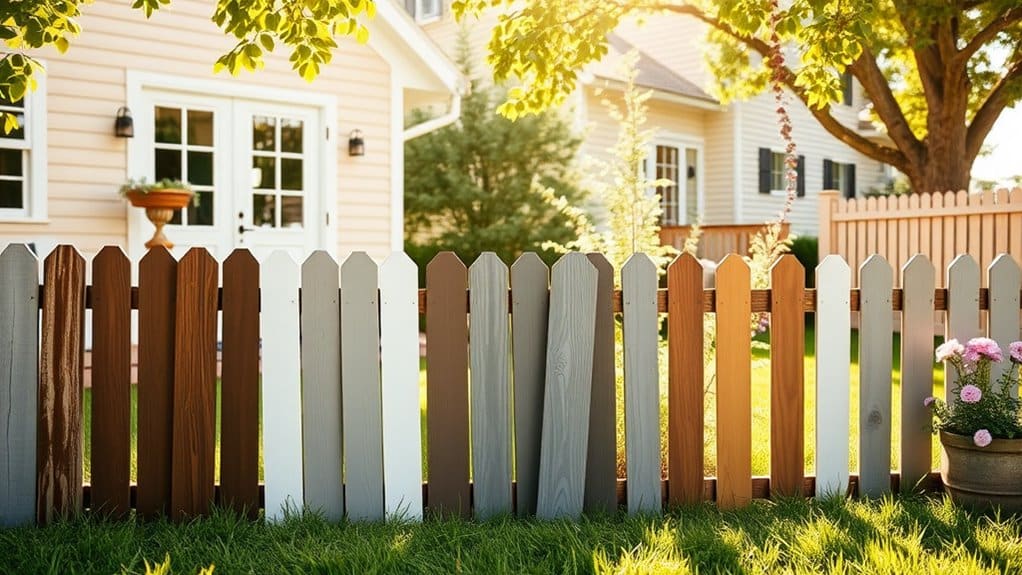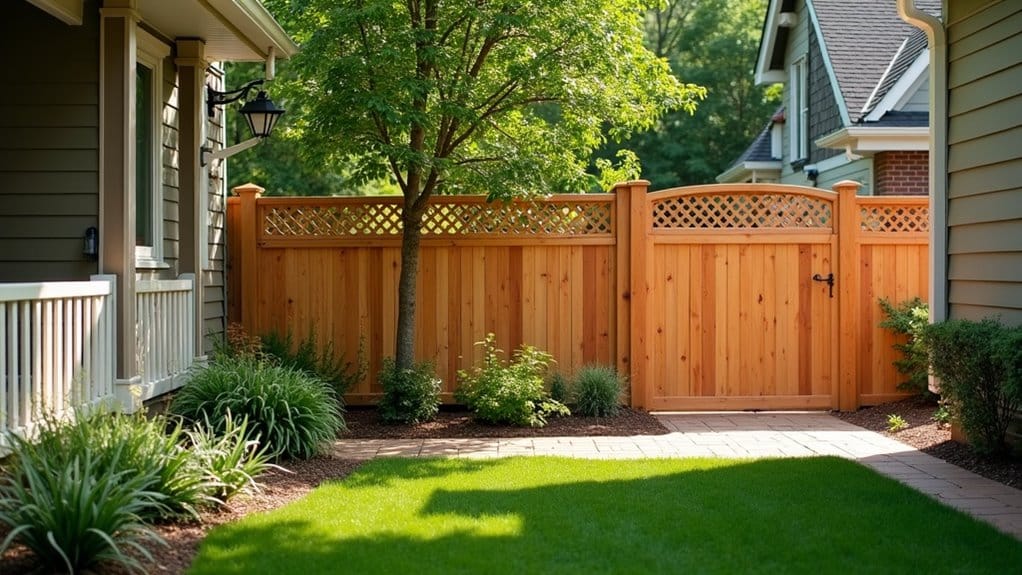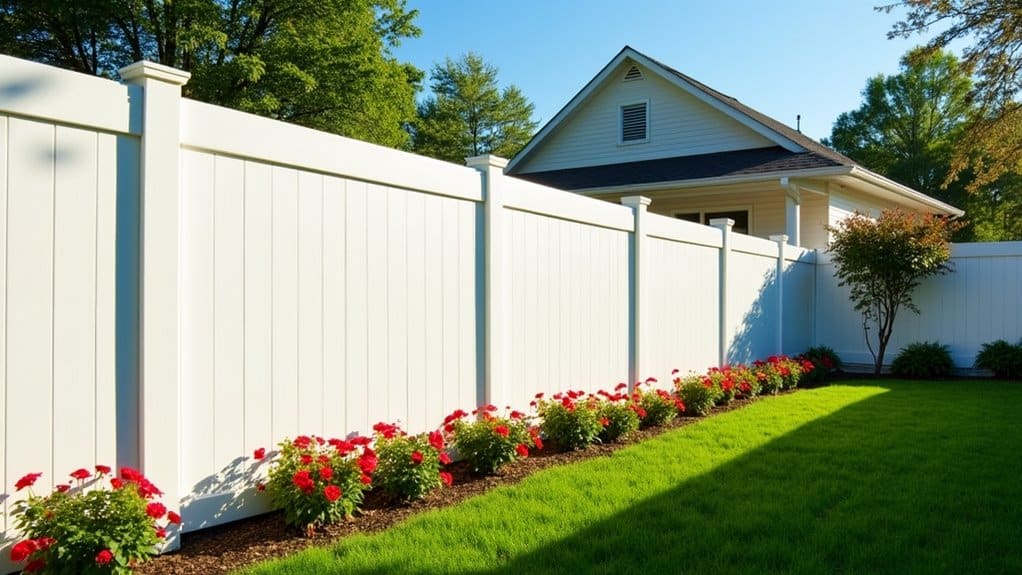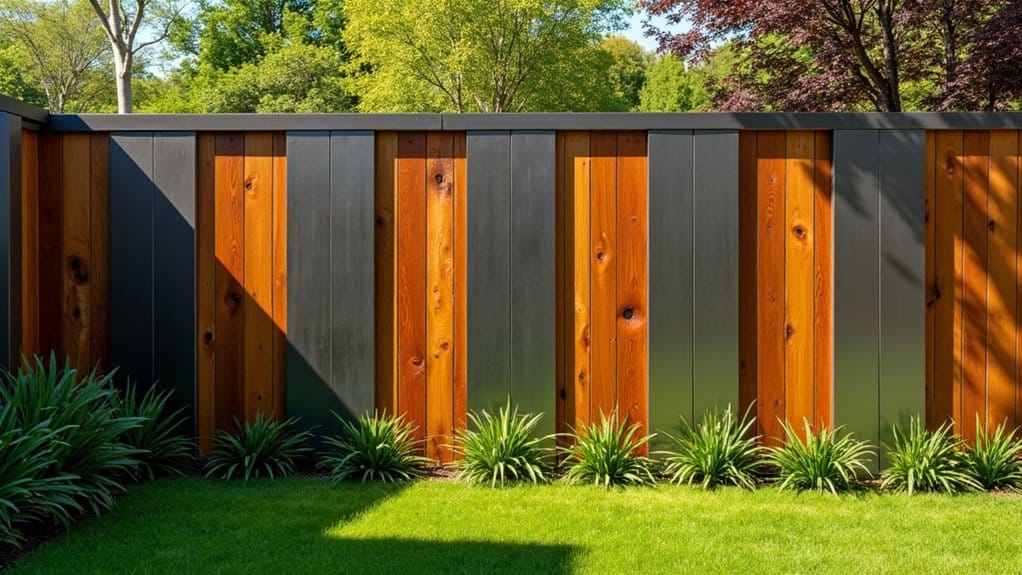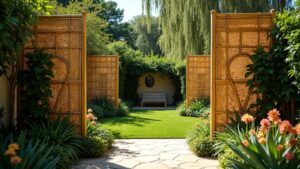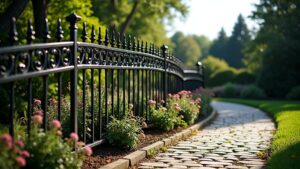Choosing the right fence color can significantly enhance your home's aesthetic. Start by matching the fence with your exterior siding: neutral tones work well with warm shades like tan or brown, while dark siding looks striking with black. Don't forget about your trim; soft grays or whites can give a modern feel.
Next, think about your landscaping. Natural wood tones complement greenery, while deeper colors can make vibrant gardens pop. Be aware of community guidelines, as they can influence your choices. Lastly, consider timeless hues or a mix for a unique look. Keep these tips in mind for a beautiful outdoor transformation.
Key Takeaways
- Choose a fence color that matches your home's siding and trim for a unified appearance. Consider your home's architectural style and what fits in with your neighborhood.
- Test color samples at different times of the day to see how they look with your home and landscaping in various lighting.
- Opt for neutral colors like white, gray, or beige for a versatile look that boosts curb appeal and works well with different plants and landscapes.
- Earthy tones or natural wood stains can complement greenery nicely, creating a welcoming outdoor area that enhances your property.
- Check your HOA rules and community preferences to ensure your fence color is in line with local standards and will positively impact your property value.
Matching Exterior Siding Color
Choosing a fence color that complements your exterior siding is important for enhancing your home's look. For neutral siding, a tan or dark brown fence can create a warm, inviting feel.
If your home has dark siding, like deep green or gray, a black or two-tone fence offers a striking contrast. In such cases, consider using metal fences for their durability and ability to hold color well over time.
For brick homes, a classic white picket or sleek black aluminum fence highlights its timeless charm.
Earthy tones, like wood stains or greens, blend well with landscaping for a cohesive look. Consider the surrounding environment to ensure your chosen color harmonizes with both your home and landscaping.
Consider seasonal trends to keep your home looking fresh, and always test colors in different lighting.
Seeking advice from professionals or exploring design inspirations can help you find the perfect match for a beautiful outdoor space.
Considering Trim and Architectural Style
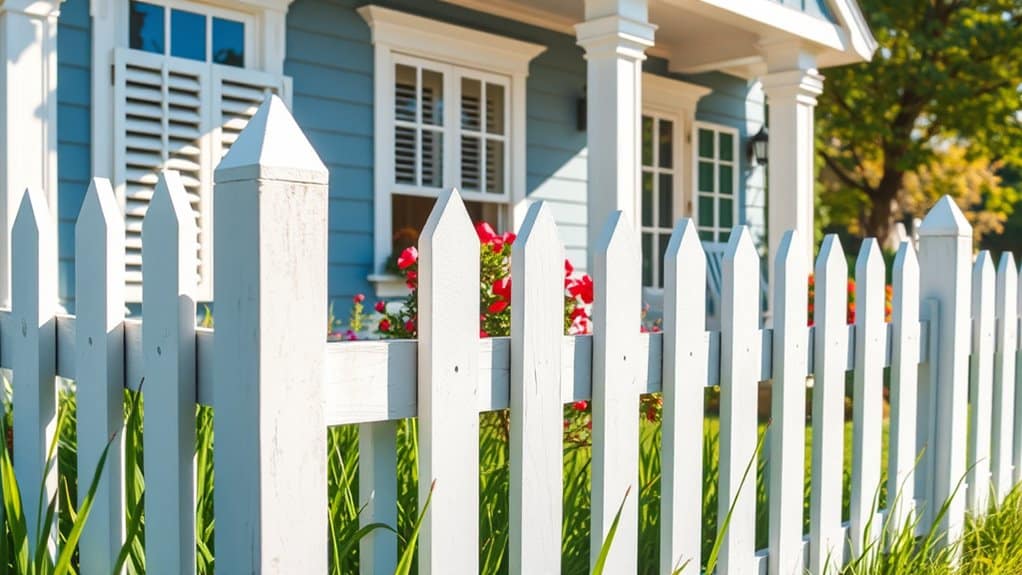
When choosing a fence color, consider how it matches your home's architectural style and trim colors. A well-selected fence can highlight your home's features and create a cohesive look. For example, if your home has white trim, a soft gray or muted blue fence can enhance its charm. Additionally, the aesthetic appeal of the fence can enhance property value and should be considered in your selection process. This choice can also lead to cost-effective solutions that require less maintenance over time, making vinyl fencing a practical option.
Align With Architectural Style
When selecting the perfect fence color, it's crucial to align it with your home's architectural style. The right color not only enhances your home's appeal but also showcases your personal taste. Color choice can increase or decrease property value, making it an important aspect of your selection process. Additionally, a well-chosen fence color can contribute to the aesthetic appeal of the property, creating a welcoming environment for visitors and neighbors.
Different fence styles and materials suit various architectural designs. For example, a sleek black fence works well with modern homes, while classic white complements colonial architecture. Rustic cottages or farmhouses benefit from warm, natural wood tones.
Here's a quick guide to the best fence colors by architectural style:
| Architectural Style | Recommended Fence Color | Ideal Fence Material |
|---|---|---|
| Modern Homes | Neutral or Gray | Composite or Metal |
| Traditional Homes | Natural Wood Tones | Wooden Pickets |
| Beach-Style Homes | White or Pastels | Vinyl or Composite |
| Ranch-Style Homes | Dark Brown or Natural Wood | Wood or Vinyl |
| Victorian Homes | Ornate Metal | Wrought Iron or Wood |
Choosing a fence color that complements your home's style creates a cohesive and inviting look.
Complement Trim Colors
Choosing a fence color that complements your trim can significantly enhance your home's exterior. When your fence matches or coordinates with your trim, it frames the house nicely and highlights its architectural features.
For example, crisp whites or soft grays can give a fresh, modern look, while bold blacks or deep navy tones add a touch of sophistication. Pay attention to current trim color trends. If your trim is a popular shade like warm cream or muted sage, opt for a fence that matches or complements it for a cohesive appearance. This coordination helps your home look unified without clashing with the main color scheme. Additionally, you might consider the historical significance of design choices in fencing to ensure your selections honor traditional aesthetics.
Also, consider other elements like shutters and window frames to achieve a seamless look. A two-tone fence design can effectively blend with both the siding and trim. Matching fence design with the home's architectural style enhances visual cohesion and overall property appeal.
Lastly, keep in mind the surrounding landscape, as greenery can affect how colors appear. With thoughtful choices, you can create a fence that enhances your home's overall charm.
Emphasize Unique Features
Your home's unique architectural features deserve a fence that enhances its charm. Here's how to choose the right one:
- Victorian Style: Bright colors and intricate designs can highlight ornate details.
- Modern Design: Opt for sleek lines and minimal detailing to complement contemporary architecture. A dark grey or black aluminum fence can create a striking visual impact against modern exteriors.
- Colonial Influence: A classic picket fence can frame a historic home beautifully, adding nostalgic appeal.
- Color Coordination: Match fence colors with your home's trim for a cohesive look.
- Historical Context: Choose a style that aligns with your home's era for a seamless integration.
Blending With Landscaping

Choosing the right fence color can significantly enhance your outdoor space and blend it with your landscaping. When selecting a color, consider how it integrates with your surroundings. Natural wood tones or stains can harmonize beautifully with greenery, while darker shades can create a striking contrast against vibrant garden colors.
Think about the mood you want to set: soft beiges or classic whites suit traditional gardens, while bold blacks and grays add a modern touch to contemporary spaces. For lush landscapes, deep greens or rich browns can complement the natural palette without overpowering it. Additionally, thoughtful landscaping around the fence can enhance its visual appeal and create a charming backdrop. A well-chosen fence color can also improve the overall property aesthetics, making your home more inviting.
Ensure the fence color coordinates with other features in your yard to avoid clashes and let your landscaping shine. By thoughtfully choosing your fence color, you can elevate your home's look and create a peaceful outdoor retreat.
Following Guidelines and Neighborhood Considerations
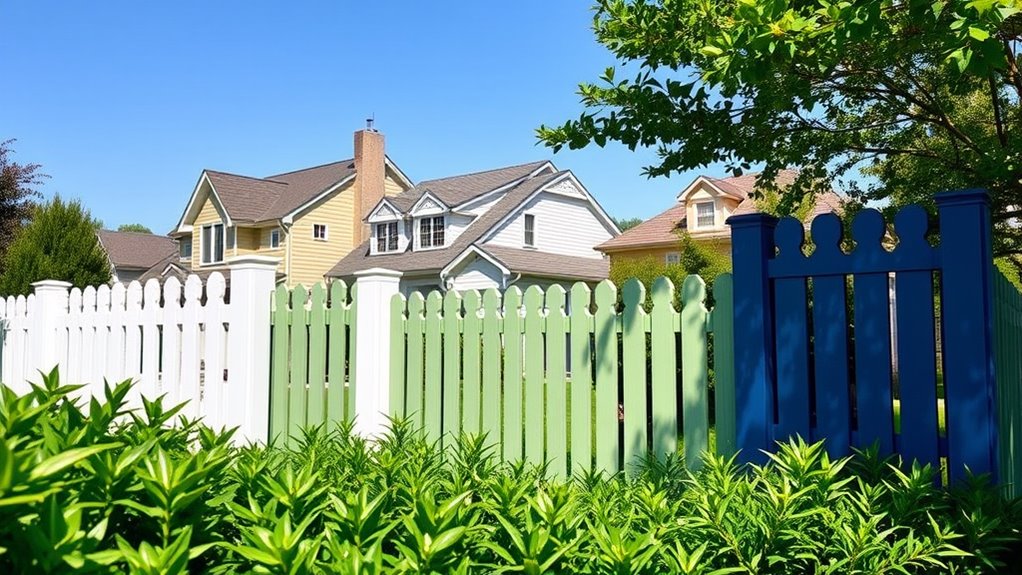
Choosing a fence color that fits your home involves understanding guidelines and neighborhood norms. Here are key points to consider:
- HOA Rules: Check if your color choice meets your homeowners' association requirements.
- Local Laws: Be aware of any restrictions on color or height in your area. Local laws can dictate what colors are permissible for fences.
- Surrounding Homes: Think about how your fence color will blend with your neighbors' properties.
- Community Preferences: Select colors that are popular in your neighborhood.
- Aesthetic Harmony: Ensure the fence color enhances your home without being too bold.
Selecting Popular and Timeless Colors
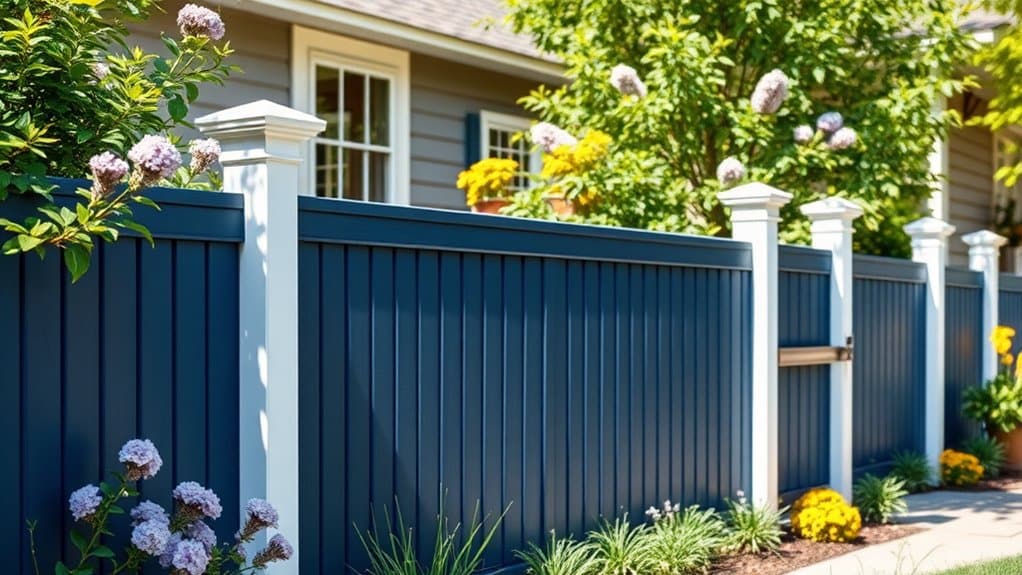
For fence colors, neutrals are a smart choice. Classic whites and soft greys blend well with any landscape, creating a timeless look. These versatile shades boost your curb appeal and ensure your design remains relevant for years to come. Additionally, vinyl fencing offers durability and low maintenance compared to wood, making it a practical option for homeowners.
Neutral Color Advantages
Choosing a neutral color for your fence can significantly enhance your outdoor space. Colors like white, gray, and beige fit well with various home styles and boost curb appeal without overpowering your property's look. A neutral fence serves as a subtle backdrop, complementing lush gardens and vibrant landscapes. Additionally, a neutral color can create a cohesive look that increases aesthetic appeal between your house and the fence.
Here are the main benefits of a neutral fence color:
- Fits various architectural styles.
- Creates a unified appearance with your landscaping.
- Enhances the natural beauty of your yard.
- Requires less maintenance and effectively hides dirt.
- Aligns with current neutral color trends.
Timeless Design Choices
Choosing a fence color can significantly enhance your outdoor space, and sticking with timeless shades ensures your selection looks great for years.
White is a classic choice that complements various architectural styles, whether traditional or modern. Shades like Surfmist and Dover White add elegance and tranquility to your surroundings. Additionally, the versatility of whites enhances architectural compatibility, making them a smart choice for any home.
For a modern touch, consider darker hues like Monument and Charcoal Grey. These colors create a sophisticated backdrop for vibrant gardens and add depth to your space.
If you prefer a nature-inspired vibe, earthy browns and sage greens blend well with the landscape, fostering a welcoming atmosphere. Coastal Blue brings a refreshing, ocean-like feel that can brighten up your home.
Don't hesitate to mix colors! Pairing white with Coastal Blue or Charcoal Grey with soft taupe can create a contemporary yet timeless look.
Whatever you choose, these classic colors will make a lasting impression.
Testing and Finalizing Fence Colors
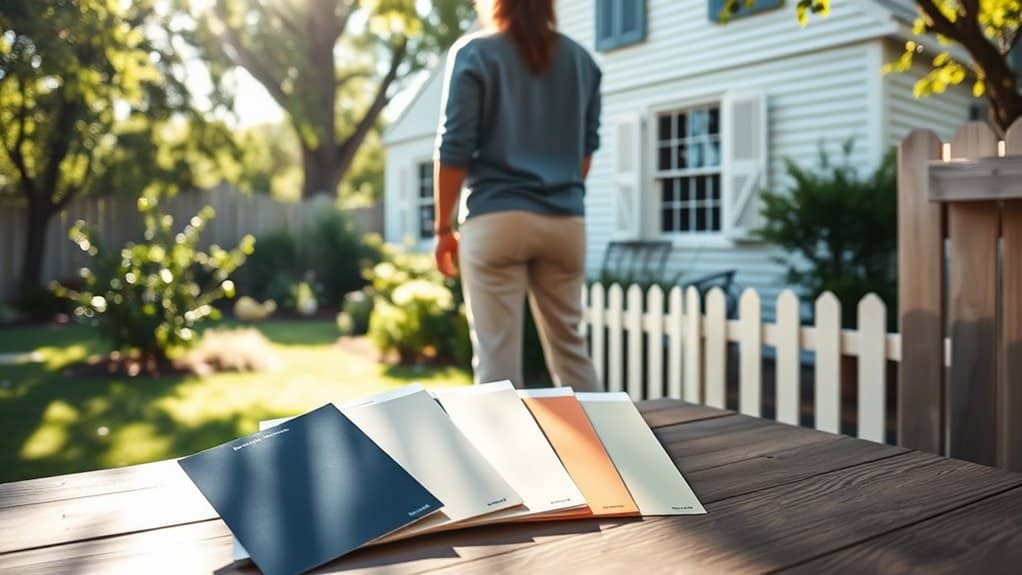
Choosing the right fence color can be an exciting process that enhances your outdoor space. Start by applying small samples of your selected colors to a section of the fence. This lets you see how they look in different lighting throughout the day.
Here are some straightforward steps to help you:
- Use color samples on your fence for a clear visual.
- Test colors at various times of the day.
- Explore online tools for additional color ideas.
- Match colors with your landscape elements.
- Ensure the color fits with your home's style.
As you refine your choices, think about how the colors work with your house siding and trim for a cohesive look.
Also, check your HOA guidelines to avoid any issues. With careful testing, you'll find a fence color that enhances your home's outdoor appeal.
Frequently Asked Questions
How Do I Choose a Fence Color for a Rental Property?
To choose a fence color for your rental property, stick to neutral tones that attract a wide range of tenants. Think about shades like beige, gray, or white that match your building and landscaping. For example, a light gray fence can beautifully complement a brick home and green yard, making it more appealing to potential renters.
What Fence Colors Increase Property Value?
Fence colors can significantly impact property value. Neutral colors like white and gray create a harmonious look, while deeper shades like navy or charcoal add sophistication. Choosing a color that complements your home can boost curb appeal and increase your property's worth.
Can I Change My Fence Color Later?
Yes, you can change your fence color later! Just check the current paint condition and think about popular color trends. Regular maintenance will help keep your fence looking fresh and ready for any updates you want.
What Materials Affect Fence Color Choice?
When selecting a fence color, think about the material. For instance, wood can offer natural beauty with rich stains, while metal provides a modern look with durable finishes. Each option affects the overall appearance of your home, so choose what complements your style best.
How Do Weather Conditions Impact Fence Color Durability?
Weather conditions significantly affect your fence's color durability. For example, strong sunlight can fade colors over time, while high moisture levels can lead to mold and rust. To keep your fence looking great, regular maintenance is crucial.
Conclusion
As you step back to view your freshly painted fence, you're filled with anticipation. Will the color complement your home's look or clash with it? You've thought through every detail—from the siding to the landscaping. Now, with your chosen color, you're ready for a transformation. The right shade can enhance your outdoor space and impress your neighbors. The moment of reveal is almost here!

